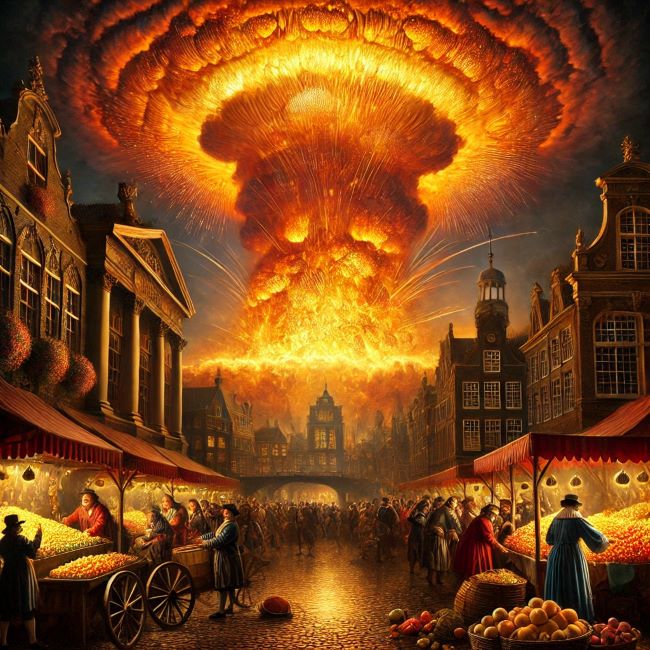The Tulip Bubble and Modern Mania: Lessons in Speculative Investing
A Costly Breakfast in Amsterdam
On a freezing February morning in 1637, pivotal news reached the counting-house of a prosperous Dutch merchant in Amsterdam.
A sailor delivered a message that a long-awaited shipment from the Levant had finally arrived. In gratitude, the merchant offered the weary mariner a breakfast of fine red herring—a delicacy the sailor chose to enjoy on the quay afterward. Casually, he grabbed what he assumed was an onion-like bulb from the countertop, planning to enhance his meal.
Unbeknownst to both men, the sailor had taken something infinitely more valuable.
Tulip Mania: The First Financial Bubble
In 17th-century Holland, tulip bulbs became symbols of wealth and prestige, sparking intense speculative interest. Rare, vividly colored varieties traded at exorbitant prices, far exceeding their intrinsic value. Specialized markets emerged, trading bulbs similarly to modern financial derivatives.
Prices skyrocketed. The Semper Augustus bulb, renowned for its striking appearance, traded for around 3,000 florins—approximately one million Euros today, equal to the cost of an upscale Amsterdam townhouse. The sailor’s “onion” was precisely this valuable variety, and its accidental consumption symbolized a significant financial loss.
However, as history consistently shows, speculative bubbles inevitably burst.
Within weeks of the sailor’s breakfast, tulip markets collapsed. Buyers vanished, prices plunged, and Haarlem’s once-thriving markets became eerily quiet. Reports of widespread financial distress and ruin emerged, underscoring the severe consequences investors faced.
Dutch Tulip Mania highlighted the Greater Fool theory, where overpriced assets remain profitable only if someone else pays even more. It also revealed deeper psychological factors like herd mentality, fear of missing out (FOMO), and persuasive narratives, which blinded investors to inherent risks. Explore more about speculative bubbles at Investopedia.
Echoes of Tulip Mania: Speculative Bubbles Through History
Initial Coin Offerings (ICOs)
During the cryptocurrency boom of 2017, ICOs like Tezos raised substantial sums based largely on novelty and speculative excitement rather than fundamental value. When the hype subsided, many investors faced substantial losses, reminiscent of tulip speculation.
Rare Stamp Collecting
Philately, or rare stamp collecting, similarly illustrates speculative risk. The 1856 British Guiana 1¢ Magenta stamp sold for $9.5 million due to its perceived uniqueness. However, subsequent authenticity doubts severely impacted its resale value, echoing how quickly speculative perceptions can change.
Peer-to-Peer (P2P) Lending
P2P lending attracted investors with promises of high returns, often without adequately explaining risks. Platforms like LendingClub and TrustBuddy faced severe financial and legal troubles, leading to investor losses analogous to uninformed tulip speculators.
Non-Fungible Tokens (NFTs)
In 2021, NFTs surged in popularity, commanding high prices for digital artwork, including Beeple’s record $69 million sale. However, this market was significantly driven by hype and digital scarcity. Many NFTs rapidly lost value as speculative interest waned.
AI-themed Cryptocurrencies
Tokens such as SingularityNET (AGIX) and Fetch.ai (FET) saw considerable value spikes fueled by speculative interest tied to AI. However, these valuations often lacked clear utility or widespread adoption, risking similar outcomes to past speculative bubbles. Learn more about AI and crypto implications.
Cryptocurrencies
Cryptocurrency investments highlight digital scarcity and speculative enthusiasm. High-profile losses, like the $450 million Mt. Gox hack, underscore the vulnerabilities and risks often underestimated during market excitement.
Historical Bubbles: Gold Rushes and Dot-Com Era
Historical events like the California Gold Rush and the late 1990s dot-com bubble further illustrate speculative cycles. Most gold seekers found limited success, while those supplying tools profited more consistently. Similarly, the dot-com bust saw numerous startups fail spectacularly, though some survivors (like Amazon and Google) demonstrated genuine underlying value.
AI Stocks: Balancing Hype and Reality
AI-focused companies such as Nvidia, Tesla, Palantir, Alphabet (Google), and Microsoft have seen rapid valuation increases, sparking concerns about potential bubbles. While AI technology indeed has transformative potential, careful analysis of profitability, adoption rates, and realistic expectations remains essential to discerning speculative excess. Explore how AI might transform capital and investments.
Prudence and Informed Investing
Emerging technologies such as blockchain and AI offer genuine, substantial benefits, potentially revolutionizing sectors like finance, property, and beyond. Nevertheless, speculative investments disconnected from real-world utility remain inherently risky.
History repeatedly emphasizes one critical lesson: speculative bubbles inevitably burst. Investors should approach new assets with informed caution, thorough research, and healthy skepticism.
Dutch tulips remind us clearly—every mania ends eventually. Those left holding overvalued assets suffer the greatest losses. Let historical lessons guide your investing strategy; remain vigilant, skeptical, and informed.

